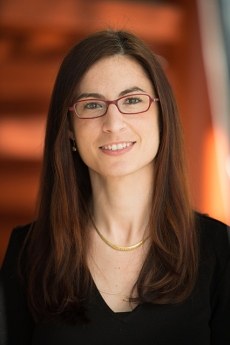Anne-Laure Papa

Anne-Laure Papa
Assistant Professor
Contact:
Professor Papa has developed an expertise in engineering novel therapeutic platforms at the interface of chemistry, biology, and medicine. She focuses her work on disease processes, particularly in cancer and vascular diseases, toward the goal of designing targeted translational therapies and new diagnostic methods. Her research is based on understanding system interactions (i.e. cell-cell and cell-particle) and delivery platforms (particle-based targeting strategies as well as cellular therapeutics). Her lab is geared to using this knowledge to identify both therapy-related and disease-related factors that can be used in a synergistic way to maximize the potential of these novel approaches.
- M. Sc., University of Bourgogne, France, 2006
- Ph.D., University of Bourgogne, France, 2009
- Postdoctoral fellow, Brigham and Women's Hospital and Harvard–MIT Program of Health Sciences and Technology, 2010-2012
- Postdoctoral fellow, Wyss Institute for Biologically Inspired Engineering at Harvard University, 2012-2017
Cellular Therapeutics
Ex vivo modified Platelets to delay Metastasis and Thrombosis: Professor Papa’s lab develops modified platelets, obtained from healthy donors, and tests them as competitive inhibitors of platelets in the bloodstream towards disrupting the vital support of platelets to circulating tumor cells. The antiplatelet effect of this new approach is also being investigated in the context of vascular diseases. The team aims to develop this new platform as a potential therapeutic, as well as a diagnostic tool with broad applications.
Next-Generation Particle based-Therapeutic Delivery
Particles have been studied as a targeting platform in disease models so as to maximize drug delivery and subsequent effect at pathological site, while decreasing adverse effects of drugs on healthy tissues. In the context of cancer, particle formulations have been approved; however, the major benefit appears to be in reducing toxicity. The team is interested in developing the next generation of particle-based therapeutic delivery (such as drug, nucleotides, proteins) and studying the interaction of these systems with the vascular endothelium, immune cells, stromal cells and plasma proteins.
Biomedical engineering
Materials
Nanotechnologies
Tissue engineering and biomaterials
A. L. Papa, N. Korin, M. Kanapathipillai, A. Mammoto, T. Mammoto, A. Jiang, R. Mannix, O. Uzun, C. Johnson, D. Bhatta, G. Cuneo, D. E. Ingber, Ultrasoundsensitive nanoparticle aggregates for targeted drug delivery. Biomaterials 2017, 139, 187-194.
A. Jain, A. D. van der Meer, A. L. Papa, R. Barrile, A. Lai, B. L. Schlechter, M. A. Otieno, C. S. Louden, G. A. Hamilton, A. Michelson, A. L. Frelinger 3rd, D. E. Ingber, Assessing Hemostasis and Platelet Function using a Microfluidic Device Lined with a Fixed Human Endothelium. Biomedical Microdevices 2016, 73.
M. G. Marosfoi, N. Korin, M. J. Gounis, O. Uzun, S. Vedantham, E. T. Langan, A. L. Papa, O. W. Brooks, C. Johnson, A. S. Puri, D. Bhatta, M. Kanapathipillai, B. R. Bronstein, J. Y. Chueh, D. E. Ingber, A. K. Wakhloo, Shear-Activated Nanoparticle Aggregates Combined With Temporary Endovascular Bypass to Treat Large Vessel Occlusion. Stroke 2015, 46, 3507-3513.
L. Maurizi, A. L. Papa, L. Dumont, F. Bouyer, P. Walker, D. Vandroux, N. Millot, Influence of surface charge and polymer coating on internalization and biodistribution of PEG-modified iron oxide nanoparticles. Journal of Biomedical Nanotechnology 2015, 11, 126-136.
A. L. Papa, J. Boudon, V. Bellat, A. Loiseau, H. Bisht, F. Sallem, R. Chassagnon, V. Berard, N. Millot, Dispersion of titanate nanotubes for nanomedicine: comparison of PEI and PEG nanohybrids. Dalton Trans 2015, 44, 739-746.
A. Pandey, S. Sarangi, K. Chien, P. Sengupta, A. L. Papa, S. Basu, A. Siddiqui, S. Sengupta, Anti-platelet agents augment cisplatin nanoparticle cytotoxicity by enhancing tumor vasculature permeability and drug delivery. Nanotechnology 2014, 25, 445101.
C. Mirjolet, A. L. Papa, G. Crehange, O. Raguin, C. Seignez, C. Paul, G. Truc, P. Maingon, N. Millot, The radiosensitization effect of titanate nanotubes as a new tool in radiation therapy for glioblastoma: a proof-of-concept. Radiother Oncol 2013, 108, 136-142.
A. L. Papa, L. Dumont, D. Vandroux, N. Millot, Titanate nanotubes: towards a novel and safer nanovector for cardiomyocytes. Nanotoxicology 2013, 7, 1131-1142.
A. L. Papa, A. Sidiqui, S. U. Balasubramanian, S. Sarangi, M. Luchette, S. Sengupta, R. Harfouche, PEGylated liposomal Gemcitabine: insights into a potential breast cancer therapeutic. Cellular Oncology 2013, 36, 449-457.
S. Sarangi, A. Pandey, A. L. Papa, P. Sengupta, J. Kopparam, U. Dadwal, S. Basu, S. Sengupta, P2Y12 receptor inhibition augments cytotoxic effects of cisplatin in breast cancer. Medical Oncology 2013, 30, 567.
A. L. Papa, S. Basu, P. Sengupta, D. Banerjee, S. Sengupta, R. Harfouche, Mechanistic studies of Gemcitabine-loaded nanoplatforms in resistant pancreatic cancer cells. BMC Cancer 2012, 12, 419.
A. Paraskar, S. Soni, B. Roy, A. L. Papa, S. Sengupta, Rationally designed oxaliplatin-nanoparticle for enhanced antitumor efficacy. Nanotechnology 2012, 23, 075103.
A. L. Papa, L. Maurizi, D. Vandroux, P. Walker, N. Millot, Synthesis of Titanate Nanotubes Directly Coated with USPIO in Hydrothermal Conditions: A New Detectable Nanocarrier. The Journal of Physical Chemistry C 2011, 115, 19012-19017.
A. L. Papa, N. Millot, L. Saviot, R. Chassagnon, O. Heintz, Effect of Reaction Parameters on Composition and Morphology of Titanate Nanomaterials. The Journal of Physical Chemistry C 2009, 113, 12682-12689.
L. Saviot, C. H. Netting, D. B. Murray, S. Rols, A. Mermet, A. L. Papa, C. Pighini, D. Aymes, N. Millot, Inelastic neutron scattering due to acoustic vibrations confined in nanoparticles: Theory and experiment. Physical Review B 2008, 78, 245426.

